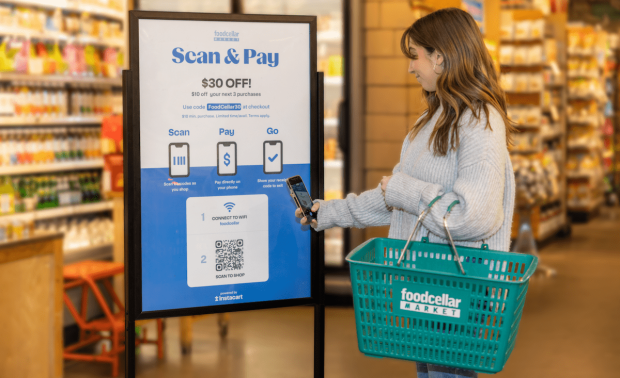Instacart Debuts Scan & Pay at NYC Grocer Foodcellar

Instacart says a Queens-based grocer is the first retailer deploying its Scan & Pay tool.
Foodcellar Market has begun allowing its shoppers to use the technology, which lets customers scan and pay for items using their smartphones, Instacart said in a Monday (Feb. 3) news release.
Scan & Pay is part of Instacart’s Connected Stores project, launched last year amid a rise in the use of digital payments in the grocery sector.
“Amidst inflation, it’s even more important for customers to stay on budget, and Scan & Pay helps Foodcellar Market’s customers track their spending as they scan items,” the release said. “No more mental calculations or being surprised at the register.”
To use the tool, customers can scan a QR code on a sign at the front of the store, which opens Scan & Pay in their mobile browser. Once they’ve finished, shoppers can check out from anywhere in their store using their phone and show a QR code as they exit to confirm that they’ve paid, according to the release.
“In the initial weeks since launch, we’ve seen Scan & Pay most utilized during peak hours — 1 p.m. and 5 p.m. — for smaller basket sizes typically less than 10 items,” the company said in the release.
Instacart introduced Connected Stores in September of last year. In addition to Scan & Pay, other new offerings include a redesigned Caper Cart smart cart that helps customers navigate the store and then check out without manually scanning items, and Carrot Tags, shelf tags that retailers can connect to Instacart to help shoppers find objects in stores.
This latest development is happening amid a decline in brick-and-mortar grocery sales, as recent PYMNTS research has found.
That study, “Changes in Grocery Shopping Habits and Perception,” found that on average, just 44% of consumers use brick-and-mortar stores as their primary source for grocery purchases. That’s a substantial drop from the 73% of consumers who said the same prior to the pandemic in early 2020.
PYMNTS’ latest surveys show that 77% of grocery shoppers overall dialed back their grocery store purchases for at least one item category.
This trend is true across all demographic groups without much variation. Forty-eight percent reduced purchases of cleaning supplies, followed by 47% for paper products and 38% for packaged items. Consumers also cut back dramatically on food purchases, especially frozen food, cut by 36% of consumers, and canned food, reduced by 35%.
Meanwhile, the rise of the digital-only grocery shopper has skyrocketed from just 0.2% before the pandemic to 7.2% — a 3,600% increase.
For all PYMNTS retail coverage, subscribe to the daily Retail Newsletter.
